Qocho
Qocho (Chinese: 高昌回鶻; pinyin: Gāochāng Huíhú; lit. 'Gaochang Uyghurs', Mongolian ᠦᠶᠭᠦᠷ Uihur "id."), also known as Idiqut,[4][5][6][7] ("holy wealth"; "glory") was a Uyghur kingdom created in 843, with strong Chinese Buddhist and Tocharian influences. It was founded by Uyghur refugees fleeing the destruction of the Uyghur Khaganate after being driven out by the Yenisei Kirghiz. They made their summer capital in Qocho (also called Qara-Khoja, modern Gaochang District of Turpan) and winter capital in Beshbalik (modern Jimsar County, also known as Ting Prefecture).[8] Its population is referred to as the "Xizhou Uyghurs" after the old Tang Chinese name for Gaochang, the Qocho Uyghurs after their capital, the Kucha Uyghurs after another city they controlled, or the Arslan (lion) Uyghurs after their king's title.
Qocho Kingdom 高昌回鶻 | |||||||||||||
|---|---|---|---|---|---|---|---|---|---|---|---|---|---|
| 843–1132 | |||||||||||||
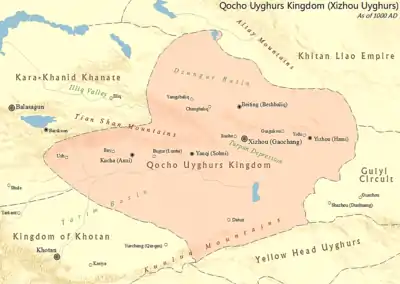 | |||||||||||||
| Status | Sovereign state (843–1132) Vassal state of the Western Liao (1132–1209) Vassal state of the Mongol Empire (1209–1335) Vassal state of the Chagatai Khanate (Late 13th to mid 14th century) | ||||||||||||
| Capital | Gaochang, Beshbalik | ||||||||||||
| Common languages | Tocharian, Middle Chinese, Sogdian, and later Old Uyghur | ||||||||||||
| Religion | Manichaeism,[1][2] Buddhism,[3] Nestorianism (Church of the East) | ||||||||||||
| Government | Monarchy | ||||||||||||
| Idiqut | |||||||||||||
| History | |||||||||||||
• Established | 843 | ||||||||||||
• Disestablished | 1132 | ||||||||||||
| |||||||||||||
| Today part of | China Kazakhstan Kyrgyzstan | ||||||||||||
Timeline
In 843 a group of Uyghurs migrated southward under the leadership of Pugu Jun and occupied Karasahr and Kucha from Tibetan Empire.
In 866, Pugu Jun declared himself khan. The Kingdom of Qocho captured Tingzhou (Beshbalik, or Beiting) and Xizhou (Gaochang) as well as Changbaliq (near Ürümqi) and Luntai (Bugur) from the Guiyi Circuit.
In 869 and 870 the Kingdom of Qocho attacked the Guiyi Circuit but was repelled.
In 876 the Kingdom of Qocho seized Yizhou from the Guiyi Circuit, after which it came to be called Kumul.
By 887 they were settled under an agrarian lifestyle in the region of Qocho.
In 954 Ilig Bilgä Tengri rose to power.
In 981 Arslan Bilgä Tengri ilig rose to power.
In 984 Arslan Bilgä Tengri ilig became Süngülüg Khagan. In the same year a Song dynasty envoy reached Qocho and gave an account of the city:
There is no rain or snow here and it is extremely hot. Each year at the hottest time, the inhabitants dig holes in the ground to live in .... The earth here produces all the five grains except buckwheat. The nobility eat horseflesh, while the rest eat mutton, wild ducks and geese. Their music is largely played on the pipa and harp. They produce sables, fine white cotton cloth, and an embroidered cloth made from flower stamens. By custom they enjoy horseback riding and archery .... They use the [Tang] calendar produced in the seventh year of the Kaiyuan reign (719). They fashion pipes of silver or brass and channel flowing water to shoot at each other; or they sprinkle water on each other as a game, which they call pressing out the sun's heat to chase off sickness. They like to take walks, and the strollers always carry a musical instrument with them. There are over fifty Buddhist temples here, the names inscribed over their gates all presented by the Tang court. The temples house copies of the Buddhist scriptures (da zang jing) and the dictionaries Tang yun, Yupian and Jingyun. On spring nights the locals pass the time milling about between the temples.There's an "Imperial Writings Tower' which houses edicts written by the Tang emperor Taizong kept carefully secured. There's also a Manichaean temple, with Persian monks who keep their own religious law and call the Buddhist scriptures the 'foreign Way' .... In this land there are no poor people; anyone short of food is given public aid. People live to an advanced age, generally over one hundred years. No one dies young.[9]
In 996 Bügü Bilgä Tengri ilig succeeded Süngülüg Khagan.
In 1007 Alp Arsla Qutlugh Kül Bilgä Tengri Khan succeeded Bügü Bilgä Tengri ilig.
In 1024 Kül Bilgä Tengri Khan succeeded Alp Arsla Qutlugh Kül Bilgä Tengri Khan.
In 1068 Tengri Bügü il Bilgä Arslan Tengri Uighur Tärkän succeeded Kül Bilgä Tengri Khan.
In 1123 Bilgä rose to power. He was succeeded by Yur Temur at some point.
In 1130 the Kingdom of Qocho became a vassal of the Qara Khitai.
In 1209 the Kingdom of Qocho became a vassal of the Mongol Empire.
In 1229, Barčuq Art iduq-qut succeeded Yur Temur.
In 1242 Kesmez iduq-qut succeeded Barčuq Art iduq-qut.
In 1246 Salïndï Tigin iduq-qut succeeded Kesmez iduq-qut.
In 1253 Ögrünch Tigin iduq-qut succeeded Salïndï Tigin iduq-qut.
In 1257 Mamuraq Tigin iduq-qut succeeded Ögrünch Tigin iduq-qut, who was executed for supporting the Ogodeid branch of the Genghisid family.
In 1266 Qosqar Tigin iduq-qut succeeded Mamuraq Tigin iduq-qut.
In 1280 Negüril Tigin iduq-qut succeeded Qosqar Tigin iduq-qut.
In 1318 Negüril Tigin iduq-qut died. The Kingdom of Qocho became part of the Chagatai Khanate.
In 1322 Tämir Buqa iduq-qut rose to power.
In 1330 Senggi iduq-qut succeeded Tämir Buqa iduq-qut.
In 1332 Taipindu iduq-qut succeeded Senggi iduq-qut.
In 1352 Ching Timür iduq-qut succeeded Taipindu iduq-qut and was the last known ruler governor of the kingdom.
By the 1370s the Kingdom of Qocho ceased to exist.
Culture
Mainly Turkic and Tocharian, but also Chinese and Iranian peoples such as the Sogdians were assimilated into the Uyghur Kingdom of Qocho.[11] Chinese were among the population of Qocho.[12] Peter B. Golden writes that the Uyghurs not only adopted the writing system and religious faiths of the Sogdians, such as Manichaeism, Buddhism, and Christianity, but also looked to the Sogdians as "mentors" while gradually replacing them in their roles as Silk Road traders and purveyors of culture.[13]
The Tang rule over Qocho and Turfan and Buddhism left a lasting legacy upon the Kingdom of Qocho with the Tang presented names remaining on the more than 50 Buddhist temples with Emperor Taizong of Tang's edicts stored in the "Imperial Writings Tower " and Chinese dictionaries like Jingyun, Yuian, Tang yun, and da zang jing (Buddhist scriptures) stored inside the Buddhist temples and Persian monks also maintained a Manichaean temple in the Kingdom, the Persian Hudud al-'Alam uses the name "Chinese town" to call Qocho, the capital city.[14]
The Uyghurs of Qocho continued to produce the Chinese Qieyun rime dictionary and developed their own pronunciations of Chinese characters, left over from the Tang influence over the area.[15]
The modern Uyghur linguist Abdurishid Yakup pointed out that the Turfan Uyghur Buddhists studied the Chinese language and used Chinese books like the Thousand Character Classic and Qieyun and it was written that "In Qocho city were more than fifty monasteries, all titles of which are granted by the emperors of the Tang dynasty, which keep many Buddhist texts as the Tripiṭaka, Tangyun, Yupuan, Jingyin etc."[16]
In Central Asia the Uyghurs viewed the Chinese script as "very prestigious" so when they developed the Old Uyghur alphabet, based on the Syriac script, they deliberately switched it to vertical like Chinese writing from its original horizontal position in Syriac.[17]
Ethnicity
While the Uyghur language is a Turkic language, James A. Millward claimed that the Uyghurs were generally "Mongoloid" (an archaic term meaning "appearing ethnically Eastern or Inner Asian"), giving as an example the images of Uyghur patrons of Buddhism in Bezeklik, temple 9, until they began to mix with the Tarim Basin's original, Indo-European-speaking "Caucasoid" inhabitants,[18] such as the so-called Tocharians. Buddhist Uyghurs created the Bezeklik murals.[19]
Religious conflict
.jpg.webp)
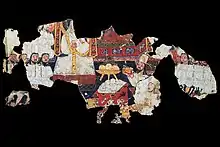
Kara-Khanid Khanate
The Uyghurs of Qocho were Buddhists whose religious identity were intertwined with their religion. Qocho was a Buddhist state with both state-sponsored Mahayana Buddhism and Manichaeism. The Uyghurs sponsored the construction of many of the temple-caves in what is now called the Bezeklik Caves. They also moved away from purely Turkic culture and abandoned the Old Turkic alphabet in favor of a modified Sogdian alphabet, which later came to be known as the Old Uyghur alphabet.[20] The Idiquts (the title of the Qocho rulers) ruled independently until they become a vassal state of the Qara Khitai (Chinese: "Western Liao").
The Buddhist Uyghurs frequently came into conflict with their western Muslim neighbors.[21] Muslim Turks described the Uyghurs in a number of derogatory ways. For example, the '"Compendium of the Turkic Dialects" by Mahmud al-Kashgari> states that "just as the thorn should be cut at its root, so the Uighur should be struck on the eye".[22] They also used the derogatory word "Tat" to describe the Buddhist Uyghurs, which means "infidels". Uyghurs were also called dogs.[23][24][25] While al-Kashgari displayed a different attitude towards the Turk diviners beliefs and "national customs", he expressed towards Buddhism a hatred in his Diwan where he wrote the verse cycle on the war against Uyghur Buddhists. Buddhist origin words like toyin (a cleric or priest) and Burxān or Furxan[26][27] (meaning Buddha,[28][29][30] acquiring the generic meaning of "idol" in the Turkic language of Kashgari) had negative connotations to Muslim Turks.[31][32]
The Uyghurs were subjected to attacks by Muslim Turks, according to Kashgari's work.[33] The Kara-Khanid Khanate's ruler Sultan Satuq Bughra Khan razed Qocho's Buddhist temples in the Minglaq province across the Ili region .[34][35][36][37] Buddhist murals at the Bezeklik Thousand Buddha Caves were damaged by local Muslim population whose religion proscribed figurative images of sentient beings, the eyes and mouths in particular were often gouged out. Pieces of murals were also broken off for use as fertilizer by the locals.[38] The Islamic-Buddhist conflict from the 11th to 12th centuries are still recalled in the forms of the Khotan Imam Asim Sufi shrine celebration and other Sufi holy site celebrations. Bezeklik's Thousand Buddha Caves are an example of the religiously motivated vandalism against portraits of religious and human figures.[39]
According to Kashgari's Three Turkic Verse Cycles, the "infidel tribes" suffered three defeats, one at the hands of the Karakhanids in the Irtysh Valley, one by unspecified Muslim Turks, and one inflicted upon "a city between the Tangut and China.", Qatun Sini, at the hands of the Tangut Khan.[40][41] The war against Buddhist, shamanist, and Manichaean Uyghurs was considered a jihad by the Kara-Khanids.[42][43][44][45] Imams and soldiers who died in the battles against the Uyghur Buddhists and Khotan are revered as saints.[46] It's possible the Muslims drove some Uyghur Buddhist monks towards taking asylum in the Tangut Western Xia dynasty.[47]
Mongol rule
In 1209, the Kara-Khoja ruler Baurchuk Art Tekin declared his allegiance to the Mongols under Genghis Khan and the kingdom existed as a vassal state until 1335. After submitting to the Mongols, the Uyghurs served the Mongol rulers as bureaucrats, providing the expertise that the initially illiterate nomads lacked.[48] Qocho continued exist as a vassal to the Mongols of the Yuan dynasty, and were allied to the Yuan against the Chagatai Khanate. Eventually the Chagatai khan Ghiyas-ud-din Baraq eliminated Yuan influence over Qocho. When the Mongols placed the Uyghurs in control of the Koreans at court, the Korean king objected. Emperor Kublai Khan rebuked the Korean king, saying that the Uyghur king ranked higher than the Karluk Kara-Khanid ruler, who in turn was ranked higher than the Korean King, who was ranked last, because the Uyghurs surrendered to the Mongols first, the Karluks surrendered after the Uyghurs, and the Koreans surrendered last, and that the Uyghurs surrendered peacefully without violently resisting.[49][50] A hybrid court was used when Han Chinese and Uyghurs were in involved in legal issues.[51]
Alans were recruited into the Mongol forces with one unit called the Asud or "Right Alan Guard", which was combined with "recently surrendered" soldiers, Mongols, and Chinese soldiers stationed in the area of the former kingdom of Qocho. In Beshbalik (now Jimsar County), the Mongols established a Chinese military colony led by Chinese general Qi Kongzhi.[52]
Conquest by Muslim Chagatais
The last Buddhist Uyghurs of Qocho and Turpan were converted to Islam by force during a ghazat (holy war) at the hands of the Chagatai Khanate ruler Khizr Khoja (r. 1389-1399).[53] Mirza Haidar Dughlat's Tarikh-i-Rashidi (c. 1540, in Persian) wrote, "(Khizr Khoja) undertook a campaign against Karakhodja [Qocho] and Turfan, two very important towns in China, and forced their inhabitants to become Muslims...".[54] The Chagatai Khanate also conquered Hami, where the Buddhist religion was also purged and replaced with Islam.[55] Ironically after being converted to Islam, the descendants of the Uyghurs in Turpan failed to retain memory of their Buddhist legacy and were led believe that the "infidel Kalmuks" (Dzungar people) were the ones who built Buddhist monuments in their area. The Encyclopaedia of Islam wrote "By then the Turks of the Turfan [...] forgetting all the other highlights of their past, they attributed the Buddhist and other monuments to the "infidel Kalmuks".[56][57]
The Islamic conversion forced on the Buddhist city of Hami was the final blow to Uyghur Buddhism,[42][58][59] although some Buddhist influence in the names of Turpan Muslims still remained.[60] Since Islam reached them much after other cities in the Tarim Basin, personal names of pre-Islamic Old Uyghur origin are still used in Hami and Turpan while Uyghurs to the west use mostly Islamic names of Arabic origin.[61] Cherrypicking of history of Xinjiang with the intention of projecting an image of either irreligiousity or piousness of Islam in Uyghur culture has been done for various reasons.[62]
The Uyghurs of Taoyuan are the remnants of Uyghurs from Turpan from the Kingdom of Qocho.
List of kings (idiquts)
The Kingdom of Qocho's rulers trace their lineage to Qutlugh of the Ediz dynasty of the Uyghur Khaganate. There are numerous gaps in our knowledge of the Uyghur rulers of Qocho prior to the thirteenth century. The title of the ruler of Qocho was idiqut or iduq qut. In 1308, Nolen Tekin was granted the title Prince of Gaochang by the Yuan Emperor Ayurbarwada. The following list of rulers is drawn mostly from Turghun Almas, Uyghurlar (Almaty, 1992), vol. 1, pp. 180–85.[63] Named rulers based on various sources of other languages are also included.[64]
- 850–866: Pan Tekin (Pangtele)
- 866–871: Boko Tekin
... - 940–948: Irdimin Khan
- 948–985: Arslan (Zhihai) Khan
... - 1126–????: Bilge (Biliege/Bilgä) Tekin
... - ????–????: Isen Tomur
... - 1208–1235: Baurchuq (Barchukh) Art Tekin
- 1235–1245: Qusmayin (Kesmez)
- 1246–1255: Salun (Salindi) Tekin
- 1255–1265: Oghrunzh (Ogrunch) Tekin
- 1265–1266: Mamuraq Tekin
- 1266–1276: Qozhighar (Qosqar) Tekin
- 1276–1318: Nolen (Neguril) Tekin
- 1318–1327: Tomur (Tamir) Buqa
- 1327–1331: Sunggi (Senggi) Tekin
- 1331–1335: Taypan (Taipingnu)
- 1335–1353: Yuelutiemur
- 1353–????: Sangge
Image gallery
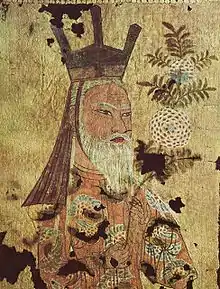 Uyghur Khagan
Uyghur Khagan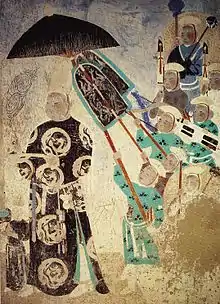 Uyghur king from Turfan
Uyghur king from Turfan Uyghur Prince from the Bezeklik murals
Uyghur Prince from the Bezeklik murals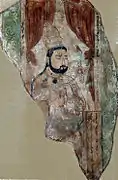 Uyghur noble from the Bezeklik murals
Uyghur noble from the Bezeklik murals.jpg.webp) Uyghur Manichaean Elect depicted on a temple banner from Qocho
Uyghur Manichaean Elect depicted on a temple banner from Qocho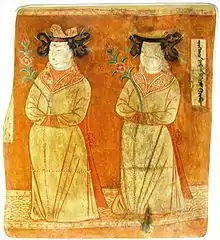 Uyghur Princesses from the Bezeklik murals
Uyghur Princesses from the Bezeklik murals Uyghur Princes from the Bezeklik murals
Uyghur Princes from the Bezeklik murals Uyghur donor from the Bezeklik murals
Uyghur donor from the Bezeklik murals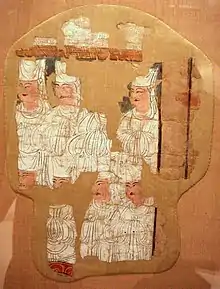 Uyghur Manichaean Electae from Qocho
Uyghur Manichaean Electae from Qocho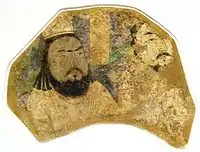 Uyghur Manichaean clergymen from Qocho
Uyghur Manichaean clergymen from Qocho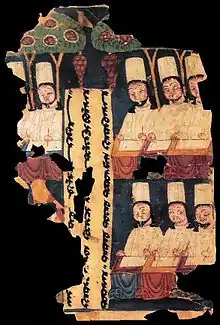 Manicheans from Qocho
Manicheans from Qocho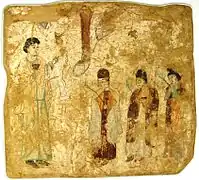
See also
Part of a series on the |
|---|
| History of Xinjiang |
 |
| History of the Turkic peoples pre–14th century |
|---|
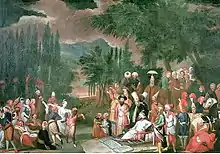 History of the Turkic peoples |
| Tiele people |
| Göktürks |
|
| Khazar Khaganate 618–1048 |
| Xueyantuo 628–646 |
| Kangar union 659–750 |
| Turk Shahi 665-850 |
| Türgesh Khaganate 699–766 |
| Kimek confederation 743–1035 |
| Uyghur Khaganate 744–840 |
| Oghuz Yabgu State 750–1055 |
| Karluk Yabgu State 756–940 |
| Kara-Khanid Khanate 840–1212 |
| Ganzhou Uyghur Kingdom 848–1036 |
| Qocho 856–1335 |
| Pecheneg Khanates 860–1091 |
| Ghaznavid Empire 963–1186 |
| Seljuk Empire 1037–1194 |
| Cuman–Kipchak confederation 1067–1239 |
| Khwarazmian Empire 1077–1231 |
| Kerait Khanate 11th century–13th century |
| Delhi Sultanate 1206–1526 |
| Qarlughid Kingdom 1224–1266 |
| Golden Horde 1240s–1502 |
| Mamluk Sultanate (Cairo) 1250–1517 |
References
- Éric Trombert; Étienne de La Vaissière (2005). Les sogdiens en Chine. École française d'Extrême-Orient. p. 299. ISBN 978-2-85539-653-8.
- Hansen, Valerie. "The Impact of the Silk Road Trade on a Local Community: The Turfan Oasis, 500–800" (PDF). Les Sogdiens en Chine.
- Stephen F. Teiser (April 1, 2003). The Scripture on the Ten Kings: And the Making of Purgatory in Medieval Chinese Buddhism. University of Hawaii Press. pp. 55–. ISBN 978-0-8248-2776-2.
- Joint Centre for Asia Pacific Studies (1996). Cultural contact, history and ethnicity in inner Asia: papers presented at the Central and Inner Asian Seminar, University of Toronto, March 4, 1994 and March 3, 1995. Joint Centre for Asia Pacific Studies. p. 137. ISBN 9781895296228.
- Sir Charles Eliot (January 4, 2016). Hinduism and Buddhism: An Historical Sketch. Sai ePublications & Sai Shop. pp. 1075–. GGKEY:4TQAY7XLN48.
- Baij Nath Puri (1987). Buddhism in Central Asia. Motilal Banarsidass. pp. 77–. ISBN 978-81-208-0372-5.
- Charles Eliot; Sir Charles Eliot (1998). Hinduism and Buddhism: An Historical Sketch. Psychology Press. pp. 205–. ISBN 978-0-7007-0679-2.
- Millward 2007, p. 46.
- Millward 2007, p. 48-49.
- SKUPNIEWICZ, Patryk (Siedlce University, Poland) (2017). Crowns, hats, turbans and helmets.The headgear in Iranian history volume I: Pre-Islamic Period. Siedlce-Tehran: K. Maksymiuk & G. Karamian. p. 253.
- James A. Millward (2007). Eurasian Crossroads: A History of Xinjiang. Columbia University Press. pp. 47–. ISBN 978-0-231-13924-3.
- James A. Millward (2007). Eurasian Crossroads: A History of Xinjiang. Columbia University Press. pp. 53–. ISBN 978-0-231-13924-3.
- Peter B. Golden (2011), Central Asia in World History, Oxford: Oxford University Press, p. 47, ISBN 978-0-19-515947-9.
- James A. Millward (2007). Eurasian Crossroads: A History of Xinjiang. Columbia University Press. pp. 49–. ISBN 978-0-231-13924-3.
- TAKATA, Tokio. "The Chinese Language in Turfan with a special focus on the Qieyun fragments" (PDF). Institute for Research in Humanities, Kyoto University: 7–9. Retrieved September 15, 2015. Cite journal requires
|journal=(help) - Abdurishid Yakup (2005). The Turfan Dialect of Uyghur. Otto Harrassowitz Verlag. pp. 180–. ISBN 978-3-447-05233-7.
- Gorelova, Liliya (2002). Manchu Grammar. Brill. p. 49. ISBN 978-90-04-12307-6.
- Millward 2007, p. 43.
- Modern Chinese Religion I (2 vol.set): Song-Liao-Jin-Yuan (960-1368 AD). BRILL. December 8, 2014. pp. 895–. ISBN 978-90-04-27164-7.
- Souček 2000, pp. 49, 79.
- Devin DeWeese (November 1, 2010). Islamization and Native Religion in the Golden Horde: Baba TŸkles and Conversion to Islam in Historical and Epic Tradition. Penn State Press. pp. 152–. ISBN 978-0-271-04445-3.
- Edmund Herzig (November 30, 2014). The Age of the Seljuqs. I.B.Tauris. p. 26. ISBN 978-1-78076-947-9.
- Edmund Herzig (November 30, 2014). The Age of the Seljuqs. I.B.Tauris. pp. 13–. ISBN 978-1-78076-947-9.
- https://web.archive.org/web/20151118063834/http://projects.iq.harvard.edu/huri/files/viii-iv_1979-1980_part1.pdf p. 160.
- Harvard Ukrainian Research Institute (1980). Harvard Ukrainian studies. Harvard Ukrainian Research Institute. p. 160.
- Giovanni Stary (1996). Proceedings of the 38th Permanent International Altaistic Conference (PIAC): Kawasaki, Japan, August 7-12, 1995. Harrassowitz Verlag in Kommission. pp. 17, 27. ISBN 978-3-447-03801-0.
- James Russell Hamilton (1971). Conte bouddhique du bon et du mauvais prince. Éditions du Centre national de la recherche scientifique. p. 114.
- Linguistica Brunensia. Masarykova univerzita. 2009. p. 66.
- Egidius Schmalzriedt; Hans Wilhelm Haussig (2004). Die mythologie der mongolischen volksreligion. Klett-Cotta. p. 956. ISBN 978-3-12-909814-1.
- http://www.asianpa.net/assets/upload/articles/LZnCyNgsTym1unXG.pdf https://www.asianpa.net/assets/upload/articles/LZnCyNgsTym1unXG.pdf https://tr.wikisource.org/wiki/Div%C3%A2n-%C4%B1_L%C3%BCgati%27t-T%C3%BCrk_dizini http://www.hasmendi.net/Genel%20Dosyalar/KASGARLI_MAHMUT_LUGATI.pdf http://www.slideshare.net/ihramcizade/divan-lugatitrk http://www.philology.ru/linguistics4/tenishev-97a.htm http://www.biligbitig.org/divanu-lugat-turk Archived August 30, 2016, at the Wayback Machine http://docplayer.biz.tr/5169964-Divan-i-luqat-it-turk-dizini.html http://turklukbilgisi.com/sozluk/index.php/list/7/,F.xhtml https://www.ceeol.com/search/article-detail?id=354765 https://www.ceeol.com/content-files/document-355264.pdf http://divanilugatitturk.blogspot.com/2016/01/c-harfi-divanu-lugat-it-turk-sozlugu_1.html https://plus.google.com/108758952067162862352 https://plus.google.com/108758952067162862352/posts/Ww2ce29Qfkz
- Dankoff, Robert (January–March 1975). "Kāšġarī on the Beliefs and Superstitions of the Turks". Journal of the American Oriental Society. American Oriental Society. 95 (1): 69. doi:10.2307/599159. JSTOR 599159.
- Robert Dankoff (2008). From Mahmud Kaşgari to Evliya Çelebi. Isis Press. p. 79. ISBN 978-975-428-366-2.
- Harvard Ukrainian Research Institute (1980). Harvard Ukrainian studies. Harvard Ukrainian Research Institute. p. 159.
- Dust in the Wind: Retracing Dharma Master Xuanzang's Western Pilgrimage. Rhythms Monthly. 2006. p. 479. ISBN 978-986-81419-8-8.
- Robert Dankoff (2008). From Mahmud Kaşgari to Evliya Çelebi. Isis Press. p. 35. ISBN 978-975-428-366-2.
- Robert Dankoff (2008). From Mahmud Kaşgari to Evliya Çelebi. Isis Press. p. 35. ISBN 978-975-428-366-2.
- Harvard Ukrainian Research Institute (1980). Harvard Ukrainian studies. Harvard Ukrainian Research Institute. p. 160.
- Whitfield, Susan (2010). "A place of safekeeping? The vicissitudes of the Bezeklik murals". In Agnew, Neville (ed.). Conservation of ancient sites on the Silk Road: proceedings of the second International Conference on the Conservation of Grotto Sites, Mogao Grottoes, Dunhuang, People's Republic of China (PDF). Getty Publications. pp. 95–106. ISBN 978-1-60606-013-1. Archived from the original (PDF) on October 30, 2012.
- Michael Dillon (August 1, 2014). Xinjiang and the Expansion of Chinese Communist Power: Kashgar in the Early Twentieth Century. Routledge. pp. 17–. ISBN 978-1-317-64721-8.
- Robert Dankoff (2008). From Mahmud Kaşgari to Evliya Çelebi. Isis Press. p. 27. ISBN 978-975-428-366-2.
- Harvard Ukrainian Research Institute (1980). Harvard Ukrainian studies. Harvard Ukrainian Research Institute. p. 151.
- Jiangping Wang (October 12, 2012). 中国伊斯兰教词汇表. Routledge. pp. xvi–. ISBN 978-1-136-10650-7.
- Jiangping Wang (October 12, 2012). Glossary of Chinese Islamic Terms. Routledge. pp. xvi. ISBN 978-1-136-10658-3.
- Jianping Wang (2001). 中国伊斯兰教词汇表. Psychology Press. pp. xvi. ISBN 978-0-7007-0620-4.
- Millward (2007), p. 43.
- David Brophy (April 4, 2016). Uyghur Nation: Reform and Revolution on the Russia-China Frontier. Harvard University Press. pp. 29–. ISBN 978-0-674-97046-5.
- Ruth W. Dunnell (January 1996). The Great State of White and High: Buddhism and State Formation in Eleventh-Century Xia. University of Hawaii Press. p. 54. ISBN 978-0-8248-1719-0.
- Souček 2000, p. 105.
- Morris Rossabi (1983). China Among Equals: The Middle Kingdom and Its Neighbors, 10th-14th Centuries. University of California Press. pp. 247–. ISBN 978-0-520-04562-0.
- Haw 2014, p. 4.
- Denis C. Twitchett; Herbert Franke; John King Fairbank (1994). The Cambridge History of China: Volume 6, Alien Regimes and Border States, 907-1368. Cambridge University Press. p. 29. ISBN 978-0-521-24331-5.
- Morris Rossabi (1983). China Among Equals: The Middle Kingdom and Its Neighbors, 10th-14th Centuries. University of California Press. pp. 255–. ISBN 978-0-520-04562-0.
- James A. Millward (2007). Eurasian Crossroads: A History of Xinjiang. Columbia University Press. pp. 69–. ISBN 978-0-231-13924-3.
- Priscilia P. Soucek (2000). Peri Bearman (ed.). The Encyclopaedia of Islam, New Edition, Volume X, T-U. Brill. p. 677.
- Dust in the Wind: Retracing Dharma Master Xuanzang's Western Pilgrimage. Rhythms Monthly. 2006. pp. 480–. ISBN 978-986-81419-8-8.
- Priscilia P. Soucek (2000). Peri Bearman (ed.). The Encyclopaedia of Islam, New Edition, Volume X, T-U. Brill. p. 677.
- Jiangping Wang (October 12, 2012). Glossary of Chinese Islamic Terms. Routledge. pp. xvi–. ISBN 978-1-136-10658-3.
- Jianping Wang (2001). 中国伊斯兰教词汇表. Psychology Press. pp. xvi–. ISBN 978-0-7007-0620-4.
- Silkroad Foundation, Adela C.Y. Lee. "Viticulture and Viniculture in the Turfan Region". Archived from the original on August 7, 2018. Retrieved June 22, 2016.
- Ildikó Bellér-Hann (2007). Situating the Uyghurs Between China and Central Asia. Ashgate Publishing, Ltd. pp. 113–. ISBN 978-0-7546-7041-4.
- Michael Dillon (August 1, 2014). Xinjiang and the Expansion of Chinese Communist Power: Kashgar in the Early Twentieth Century. Routledge. pp. 4–. ISBN 978-1-317-64721-8.
- As duplicated and augmented in George Qingzhai Zhao, Marriage as Political Strategy and Cultural Expression: Mongolian Royal Marriages from World Empire to Yuan Dynasty (Peter Lang, 2008), p. 165–66, 174–76.
- https://www2.ihp.sinica.edu.tw/file/4479VVAuKec.pdf
Bibliography
- Asimov, M.S. (1998), History of civilizations of Central Asia Volume IV The age of achievement: A.D. 750 to the end of the fifteenth century Part One The historical, social and economic setting, UNESCO Publishing
- Barfield, Thomas (1989), The Perilous Frontier: Nomadic Empires and China, Basil Blackwell
- Benson, Linda (1998), China's last Nomads: the history and culture of China's Kazaks, M.E. Sharpe
- Bregel, Yuri (2003), An Historical Atlas of Central Asia, Brill
- Bosworth, Clifford Edmund (2000), The Age of Achievement: A.D. 750 to the End of the Fifteenth Century - Vol. 4, Part II : The Achievements (History of Civilizations of Central Asia), UNESCO Publishing
- Bughra, Imin (1983), The history of East Turkestan, Istanbul: Istanbul publications
- Drompp, Michael Robert (2005), Tang China And The Collapse Of The Uighur Empire: A Documentary History, Brill
- Golden, Peter B. (2011), Central Asia in World History, Oxford University Press
- Haywood, John (1998), Historical Atlas of the Medieval World, AD 600-1492, Barnes & Noble
- Latourette, Kenneth Scott (1964), The Chinese, their history and culture, Volumes 1-2, Macmillan
- Mackerras, Colin (1990), "Chapter 12 - The Uighurs", in Sinor, Denis (ed.), The Cambridge History of Early Inner Asia, Cambridge University Press, pp. 317–342, ISBN 0-521-24304-1
- Mergid, Toqto'a (1344), History of Liao
- Millward, James A. (2007), Eurasian Crossroads: A History of Xinjiang, Columbia University Press
- Mackerras, Colin, The Uighur Empire: According to the T'ang Dynastic Histories, A Study in Sino-Uighur Relations, 744–840. Publisher: Australian National University Press, 1972. 226 pages, ISBN 0-7081-0457-6
- Rong, Xinjiang (2013), Eighteen Lectures on Dunhuang, Brill
- Sinor, Denis (1990), The Cambridge History of Early Inner Asia, Cambridge University Press, ISBN 978-0-521-24304-9
- Soucek, Svat (2000), A History of Inner Asia, Cambridge University Press
- Xiong, Victor (2008), Historical Dictionary of Medieval China, United States of America: Scarecrow Press, Inc., ISBN 978-0810860537
- Xue, Zongzheng (1992), Turkic peoples, 中国社会科学出版社
_in_%E7%95%AA%E5%AE%A2%E5%85%A5%E6%9C%9D%E5%9C%96_(937-976_CE).jpg.webp)
.jpg.webp)
.jpg.webp)